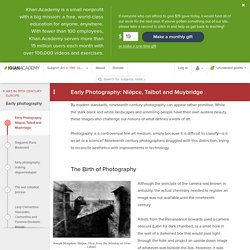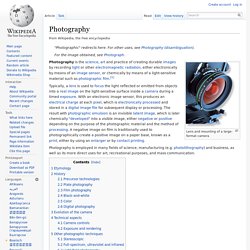

Early Photography: Niépce, Talbot and Muybridge. By modern standards, nineteenth-century photography can appear rather primitive.

While the stark black and white landscapes and unsmiling people have their own austere beauty, these images also challenge our notions of what defines a work of art. Photography is a controversial fine art medium, simply because it is difficult to classify—is it an art or a science? Nineteenth century photographers struggled with this distinction, trying to reconcile aesthetics with improvements in technology. The Birth of Photography Joseph Nicéphore Niépce, View from the Window at Gras (1826)Although the principle of the camera was known in antiquity, the actual chemistry needed to register an image was not available until the nineteenth century.
Artists from the Renaissance onwards used a camera obscura (Latin for dark chamber), or a small hole in the wall of a darkened box that would pass light through the hole and project an upside down image of whatever was outside the box. Technological Improvements. History of Photography and the Camera. Updated October 05, 2015. continue reading below our video Niepce placed an engraving onto a metal plate coated in bitumen, and then exposed it to light.

The shadowy areas of the engraving blocked light, but the whiter areas permitted light to react with the chemicals on the plate. When Niepce placed the metal plate in a solvent, gradually an image, until then invisible, appeared. However, Niepce's photograph required eight hours of light exposure to create and after appearing would soon fade away. In 1839 after several years of experimentation and Niepce's death, Daguerre developed a more convenient and effective method of photography, naming it after himself - the daguerreotype. Daguerre's process 'fixed' the images onto a sheet of silver-plated copper.
In 1839, Daguerre and Niepce's son sold the rights for the daguerreotype to the French government and published a booklet describing the process. Talbot sensitized paper to light with a silver salt solution. Metro Detroit Michigan Wedding Portrait Photography - J. Lynn Photography. 21 photography facts you probably never knew. We’ve put together 21 fascinating, puzzling, and bizarre facts about photography that you probably never knew.

If the next pub quiz you attend asks you what was the most expensive camera ever sold, how big the largest ever photograph was, or how many Hasselblads there are on the moon, you’ll be glad you read this post. (And if you win, you owe us a drink.) Biology and Photography The f-number of the human eye varies from about f/8.3 in brightly lit conditions, to about f/2.1 in dark conditions.Source: Wikipedia To work out the focal length of the human eye, you would need to take into account the light-reflecting properties on liquids in the eye.Source: Wikipedia F-numbers are actually written as they are due to human biology, or more specifically, due to the logarithmic nature of human perception. Human behaviour and photography Today we snap as many photos every two minutes as humanity as a whole did in the 1800s.Via: Fstoppers Which is your best side?
The Power of Photography. Photographers use their cameras as tools of exploration, passports to inner sanctums, instruments for change.

Their images are proof that photography matters—now more than ever. By Robert Draper Thirty-four years before the birth of this magazine, the Danish philosopher Søren Kierkegaard sourly prophesied a banal fate for the newly popularized art of photography. “With the daguerreotype,” he observed, “everyone will be able to have their portrait taken—formerly it was only the prominent—and at the same time everything is being done to make us all look exactly the same, so we shall only need one portrait.”
Photography and Photos of the Day - National Geographic. Photography. For the image obtained, see Photograph.

Lens and mounting of a large-format camera Photography is the science, art and practice of creating durable images by recording light or other electromagnetic radiation, either electronically by means of an image sensor, or chemically by means of a light-sensitive material such as photographic film.[1] Photography is employed in many fields of science, manufacturing (e.g. photolithography) and business, as well as its more direct uses for art, recreational purposes, and mass communication. Etymology[edit] The word "photography" was created from the Greek roots φωτός (phōtos), genitive of φῶς (phōs), "light"[2] and γραφή (graphé) "representation by means of lines" or "drawing",[3] together meaning "drawing with light".
Several people may have coined the same new term from these roots independently. History[edit] Precursor technologies[edit] A camera obscura used for drawing images. Photography. Photography. Photography. Photography. Photography. Bokeh photography 03. Photography. Picture 1. Watu wazuri photography1.